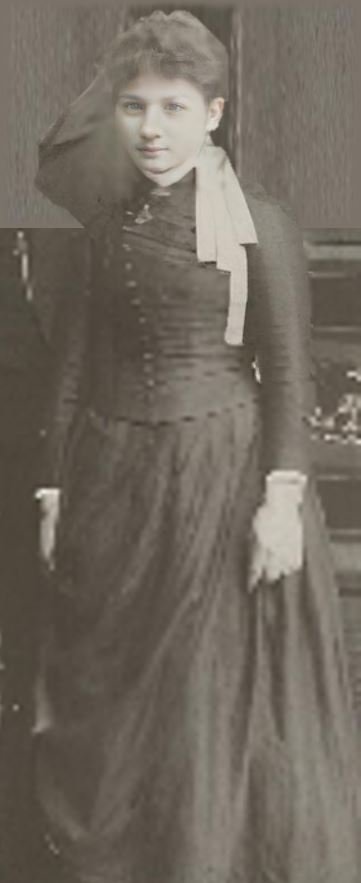THE FUTURE OF CHARLES
Indiana Chapter 4
INTRO EUROPE GERMANY OHIO INDIANA SOUTH DAKOTA NEW MEXICO KANSAS DEEPER LOOKS BOOK
Clara Malinda Berkey, age 17.
A chance encounter led Charles into his most important future partnership
In the energetic trading center of downtown Wakarusa, IN, Charles first met Clara Malinda Berkey. Clara was clerking in one of the dry goods stores.
Just as the Link family, the Berkey family was earlier emigrated from Germany. George and Frances Berkey now owned a farm one and a quarter miles north of Wakarusa. They were not Mennonite, however. They were members of the Methodist church.
The Berkey family was large, including nine children. A tremendous barn fire broke out during threshing work on the Berkey farm in 1875 and killed one of Clara's brothers, John F. Berkey. The Reverend John Metzler gave the funeral discourse in German. Most German immigrants, including Mennonites and Methodists, spoke German in meeting settings and at home. Area church services were presented in German unless there were guests who were not of German descent.
The George Berkey family, 1890. Clara Malinda on the far right.
Clara was born August 31, 1873, in Wakarusa. In an 1890 Berkey family portrait, she would have been about 17. The year of that portrait, 1890, was the year prior to marrying Charles. The portrait has been enhanced, but is believed to be accurate.
Clara's mother, Frances (Newcomer) Berkey, was born February 14, 1837, in Fayette County, PA. Clara's father, George Berkey was born September 25, 1830, in Paint Township, Holmes County, OH. In the photograph, George appears to have a big smiling face. A Berkey descendant, Lowell Nunemaker, said that George was known as a very affable and gregarious soul. So at a time when smiling in portraits was uncommon, George was doing so.
According to Mary (Jones) Henry, granddaughter of Charles and Clara, George Berkey’s father was John Barkey (spelled with an “a”). John was a minister of the Longenecker Mennonite Church in Holmes County, OH. Frances’ father was also a Mennonite minister. All four parents of George and Frances are buried next to one another in the cemetery beside their church in Holmes County, OH.
A book written in 1980 by James O. Lehman, Growth Amidst Struggle, includes information about both Barkey/Berkey and Newcomer families in the life of that Ohio community. The Berkey family in Indiana, however, had become Methodists some time before leaving Ohio, according to the obituary for George. He served as a trustee in the Methodist church of Wakarusa.
Charles Ulysses Link and Clara Malinda Berkey were married on January 18, 1891, and lived on the Link family farm with Jacob and Elizabeth. They started their family at the farm and had six children. One, Mabel Ruth, died in infancy at just six months. Her birth records are from the town of Elkhart proper, some distance for that time. The birth might have been expected to be difficult to result in travel of over an hour by horse carriage to where more advanced medical help was available.
George Berkey’s moustache cup. Such cups were very popular from 1890 to 1910 to keep handlebar moustaches protected from getting wet. Many designs had the word “present” on them, some in raised letters.
George Berkey’s moustache sentiment cup
Invented in the 1860 by Englishman Harvey Adams, the popular cups not only protected handlebar and other “extreme moustaches” from dripping after tea, or the American habit of coffee*, but also carried verbal sentiments applied by hand with paintbrush. Some carried generic names for family members, such as “Papa” or thoughts such as “Health and Happiness.” The cups that say “Present” were labeled for being given to someone as a present. A few of this sentiment would say “A Present.” Others proclaimed “Think of me,” also a popular gift idea.
In the 1920’s those Victorian Era cups abruptly drifted from production. When popular, however, they were designed even by top china manufacturers, including Royal Crown Derby, Limoges, Royal Bayreuth and even Tiffany. Their demise was not a mystery, however. It parallelled the end of popularity of the handlebar moustache that had been worn by many from Wyatt Earp to soldiers in European armies in the late 1800s.
* Coffee gained rapidly in American fashion after the Boston Tea Party of 1773. That episode in revolutionary history made imported tea an unpatriotic choice literally overnight for those who resented taxation they considered high and for which they did not feel represented in London. It was not until 1848 that Junius Smith began growing tea commercially in the southern state of South Carolina.
A new generation of Indiana farmers
The first child born to the family, on September 3, 1891, was Forest Elmer.
Children were again being raised on the farm. Life became busier. Clara did cooking, baking and canning at home, as well as the milking of dairy cows and the family washing. C.U. now managed the farming operations for Jacob and Elizabeth which required the ability to plan and make financial decisions.
Family farms are basically manufacturing businesses but ones where the ingredient supply chain is completely at the mercy of weather. Decisions of how much to produce are made several months in advance of knowing actual demand or the final price the “products” can be sold for. And, instead of being produced inside of a factory building, the production line is outdoors and subject to the whims of Mother Nature.
So in the very best of years, farming was gambling. However, gambling for the essential purpose of feeding not only a single family, but increasingly a growing nation. As more people in larger cities became involved in industrial production, more family farms were able to sell excess to feed those who were otherwise engaged, and not feeding themselves. So demand, generally, was increasing for farming production.
On the horizon, however, economic thunderstorms were gathering. Far-reaching market changes were soon coming for farmers in Indiana and across the 45 United States. Changes that would affect farms for a long period. But in the meanwhile, the Link family was growing and prospering in their new homeland.
Forest Elmer Link - 1891
Edna Frances Link - 1893
Oscar Ray Link - 1895
Elden Wallace Link - 1897
Mabel Ruth Link - 1901
Mary Elizabeth Link - 1904
Charles and Clara Link.
Edna Frances and Forest Elmer Link.






